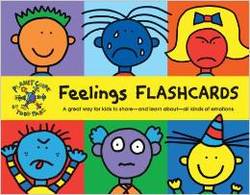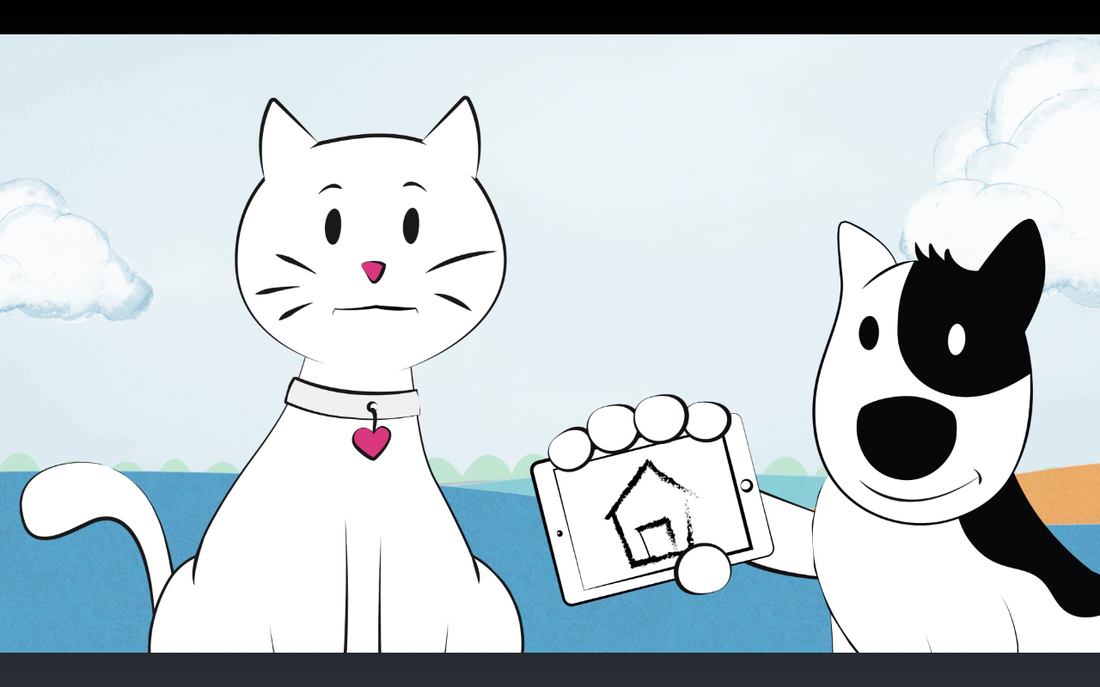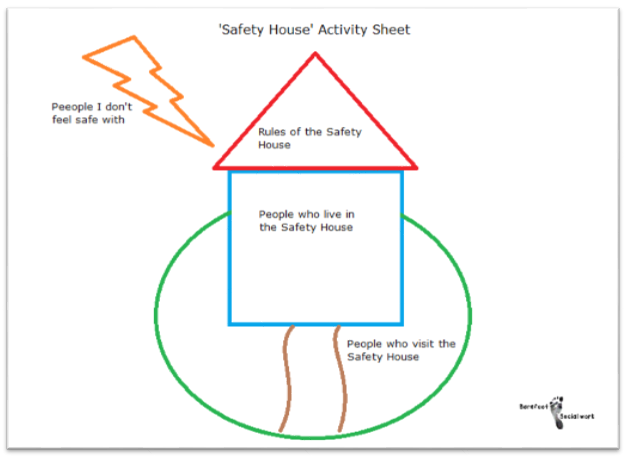|
In 2010/11 Professor Eileen Munro reviewed the English children’s services system and found organizations and workers had become over-bureaucratized and compliance driven at the expense of direct work with families, parents and children. Following the recommendations of the Munro review, the UK government launched a Children’s Services Innovations programme which, amongst other things, has financed the development of a new app for social workers to use in their practice with children and families. Developed in Western Australia and designed with children’s services practitioners in UK, USA and Australia, the My Three Houses App offers a tool that taps into children’s love of all things iPad and encourages them to speak about what is happening in their life. The three houses tool was first conceived in New Zealand in 2003 and since then has been used by social workers all over the globe to place the voice of the child at the centre of child protection assessment and planning. I've blogged about using the analogue version here. This app brings the tool into the digital realm. There's video... Interactive animation... and a drawing pad for children.
0 Comments
A year or so ago, I remember reading an article on The New Social Worker by Addison Cooper about ‘How Movies Can Help in Working with Kids’. If you haven’t read it, I recommend you do. It won’t take very long. Basically, she talks about how ‘movies can provide an excellent and easy way to connect with clients’ and ‘provide them with understandable analogies’. I think most Children’s Social Workers draw upon popular culture in their work. Cbeebies characters provide a universal conversation starter for most pre-schoolers and The X Factor is usually good with Teens. But we can also, as Addison points out, use them to help children understand their own emotions and circumstance. This summer’s movie Inside Out has received fantastic reviews and looks like a brilliant resource and tool for Social Workers. Take a look at the trailer if you haven’t already seen it. An article in The Guardian calls it a crash course in PhD Philosophy of self. It tells the story of 11 year old Riley, who moves to a new city and tries to make sense of her environment. The central characters Joy, Sadness, Anger, Fear and Disgust live in Headquarters, the control centre inside Rileys mind. Of course, in reality, there are more than just five emotions but that would have made the storyline a little too complicated. Whilst initially viewers may perceive most to be negative emotions, as the movie progresses we see how they work together and play an important role in keeping Riley safe. A message that Social Workers will understand and be able to relate to in their practice. During one scene Joy tells Sadness, drawing a small circle around the blue character, “your job is to make sure that all the sadness stays inside of it”. I find this quite profound as it is often what we see children encouraged to do when they are struggling with their emotions. Sadness and Anger can manifest in all sorts of ways that society perceives to be negative. Schools and classrooms aren't always set up to deal with the individual emotional needs of a pupil when their behaviour is seen to be impacting upon the learning of others around them. So, they are encouraged to ‘behave’, ‘be quiet’ and ‘calm down’. Hopefully Inside Out will help others to interpret children’s actions and foster empathy. It might also resonate with parents struggling to understand their child and how they can best support them. I’ve put together a couple of resources that you might like to use. Please feel free to download and share. Amazon also sell figures that could be incorporated into direct work or you can print off some of the colouring pages from the Disney website.
 The Munro Review highlighted that the only way to create a “child-centred” system was for social workers to have the time and the skill to undertake a great deal more direct work with children. NICE has also recommended that professionals take greater steps to actively involve children and young people in the process of entering care, changing placement, or returning home and a series of intervention tools should be considered to help guide decisions on interventions for children and young people. What this means is that there is a general consensus that there should be a greater focus on direct work in professional practice. Direct work with children is a complex skill to master but the techniques can be relatively simple. Here are a couple of ideas that I have found to be effective in the past. In most cases all you need is pen, paper and time. The 'Three Houses' technique was created by Nicki Weld and Maggie Greening in New Zealand (Weld 2008, cited by Turnell 2012) and is mentioned in the Munro review. It helps a child or family think about and discuss risks, strengths, and hopes. It is usually most effective with older children or with families where you are finding it difficult to devise an effective intervention plan and can be used with individuals or a group. Taking three diagrams of houses in a row, Social Workers explore the three key assessment questions: 1) What are we worried about, 2) What’s working well and 3) What needs to happen/how would things look in a perfect world. Start by presenting the three blank houses to the child or they could draw their own. Beginning with the ‘House of Good Things’, the child is asked what the best things are about living in the house and questioning is directed around positive things that the child enjoys doing there. After this stage you should progress to discuss the ‘House of Worries’ and find out if there are things that worry the child in the house or things that they don’t like. Finally the ‘House of Dreams’ covers an exploration of thoughts and ideas the child has about how the house would be if it was just the way they wanted it to be. A description is built up detailing who would be present and what types of behaviours would occur. The ‘Safety House’ tool was developed by Sonja Parker. It helps to represent and communicate how safe a child feels in their own home and what could be done to improve things. It can be used with children who are not currently living with parents in order to plan for reunification. Progress can also be assessed by changes in the safety house drawing and can be a key tool in the assessment of risk and safety planning. Start with a picture of a house with a roof, path and garden. The house and garden are divided into sections and the child can describe who they would like to live with them, who can visit and stay over and who is not allowed to come into the house. Safety rules are devised and put into the roof of the house and details of what happens in the house and what people do can be discussed. The house can also be utilised as a readiness scale by using the path as an indicator of how ready they are to return home.  The faces technique involves asking the child to pick from a range of different facial expressions and assigning them to members of their family. It is a useful method for discovering how a child perceives their family and is likely to appeal to younger children or those at an earlier stage of development. After explaining to the child that you want to know more about their family, show them some pictures of different facial expressions, making sure they understand each expression and the emotion it relates to. You could draw them yourself or use a professional set. I recommend the Todd Parr Feelings Flash Cards which are really attractive and accessible for young children. They’re also thick, sturdy and, most importantly, durable. For more developed children, you can select a wide range of expressions; for those at earlier stages of development, you might want to just use two or three (ie happy, sad and angry). There are many other activities that are effective in direct work with children and young people. I will try to write more posts soon. Follow me on facebook or twitter so you don't miss them! In the meantime, you might like to take a look at Audrey Tate’s book, Direct Work with Vulnerable Children. It’s primarily a set of playful activities to create opportunities to engage children. Through these activities children are enabled to tell their stories and provide Social Workers with assessment and support opportunities. For the last few weeks I’ve been posting about a six week course I’ve been taking called Psychology and Mental Health: Beyond Nature and Nurture. Today is the penultimate week and we have been consolidating the last four weeks learning and identifying how these psychological insights can help us and our clients maintain mental health and well-being. We looked at a recent UK Government report into well-being and considered how we might be able to incorporate its findings into our professional practice. The report was drafted by a team at the new economics foundation (NEF) and presented evidence for things individuals could do themselves to achieve greater well-being. They concluded that people should follow a well-being equivalent of the ‘five fruit and vegetables a day’ rule. You can view the full report here. In summary, they recommended the following:  Keep active When people are physically active they tend to have better mental health. Simple things like going for a walk, mowing the lawn, washing the car are just as effective as going to the gym or running.  Maintain relationships There are things that people can do every day to maintain their connectivity with other people, and to maintain their relationships. Phone a relative/friend, send a postcard, write a letter, or even use social media.  Learn It doesn't have to be formal learning at a university or college, it could be as simple as reading a newspaper/book, doing a crossword or going to the library. Things that keep the brain active and engaged are good for our mental health.  Give Research has shown that people who give – time, money and/or energy – tend to have better mental health than those who don’t.  Be mindful There's a growing body of evidence that an approach called mindfulness is good for our mental health. And that means that every day we can make sure, we can bear in mind, to be aware of the things that we're looking at, the things that we're smelling, the things that we're seeing, our own thoughts, and the functioning of our own bodies, to be aware of and to be engaged with the world rather than just simply passively moving through it. We also looked at a selection of resources available to help maintain mental health and well-being. I thought you might also be interested as they can be used to inform personal or professional strategies. Here they are... Catch It, Check It, Change It The University of Liverpool has recently developed a smartphone app for iPhone and Android. Designed to introduce key ideas from cognitive behavioural therapy (CBT), the app allows users to keep a record of their moods, therefore allowing them to reflect on what affects their feelings. It is hoped that this, in turn, will help them to control their moods. It is not proposed that the app could or would ever replace direct therapy; rather the purpose is to provide an understanding of CBT; helping people to gain a little more insight into, and control over, their emotions. Activity Scheduling Activity is an excellent anti-depressant. But when people are depressed, they often find it difficult to motivate themselves to become active. So clinical psychologists often give their clients simple diaries to keep track of their activity. The BBC’s Activity Scheduling guide is a fantastic resource that you could use yourself or incorporate into your practice with clients. Graded Exposure Anxiety is a common problem which can be reduced through a well-tested therapeutic approach called graded exposure. The basic aim is to help people gradually build up their confidence in addressing a problem that causes them anxiety; step by step. You might find this graded exposure activity sheet helpful. Structured Problem Solving Research has found that rumination can be a key problem in maintaining mental health. However, it has also been found to be a protective factor for people if they had well-developed skills in ‘adaptive coping’. One approach to helping people develop these kinds of skills is called ‘structured problem solving’. This really means breaking down problems into their constituent components and generating possible solutions for each element. Again, the BBC has a simple worksheet available which you might like. Next week will be the last session and I've been told we will be looking at how we can use what we have learned so far to design and commission better mental health and well-being services. If this is something you'd be interested in reading about please follow me on facebook so that you don't miss it. Have a great week! A friend asked me about e-safety today. She was concerned after finding her child on an inappropriate website and panicked. Her initial reaction was to revoke all on-line privileges as she did not feel confident in her ability to manage the situation. This is a natural reaction. We often want to remove our children from all situations which might cause them harm but in this day and age, it isn't particularly realistic. Children need to learn how to use computers and the internet. It will play a huge part in their lives growing up and should be supported if they are to enjoy and achieve, make a positive contribution and achieve economic well-being. So, here are my top tips for protecting young children (Foundation and Key Stage 1) whilst on-line. I will write a separate post for older children at a later date.
It's never too early to start talking to your child above staying safe on-line. There are a number of great resources available for parents and professionals to download. One of my current favourites is Smartie the Penguin by ChildNet International. You can download the story from the tools section of this website along with prompts for exploring the themes raised. It is a great way of introducing the boundaries we highlighted earlier in a child centred way.
The story follows Smartie the Penguin as he learns what to do when pop ups appear, when he finds himself on an inappropriate webpage and when he receives a message from a stranger. There are also a number of books that you can share with children to explain the importance of internet safety. Chicken Clicking is described as Little Red Riding Hood for the iPad generation; this is the perfect book for teaching children how to stay safe online. Penguinpig teaches children about stranger danger online. When a little girl reads about a penguinpig on the Internet, she decides that she must go and find one. Not telling her parents, she sets off to the zoo and carefully follows the instructions from the website. Penguinpig has received acclaim from children's authors Andrew Cope and Ian Whybrow, and has been recommended for families and schools by Claude Littner (BBC1's The Apprentice). The Internet is Like a Puddle by Big Hug Books attends to the wonderful aspects of electronic communication as well as gently discusses some of the possible pitfalls of sharing, chatting and using data. The Big Hug books grew out of letters sent to children and their families after their psychology sessions. Each book has its origins in a real need for a real child with a real problem and offers real strategies from a real psychologist. The heart-felt illustrations and simple words aim to simplify tricky situations and soothe strong emotions. The books aim to give children, and the people who care for them, a way to talk about problems. Digiduck's Big Decision is an illustrated children's book that tells the story of Digiduck and his friends, to help children understand how to be good friends to others on the internet. Designed for children age 3-7 years (Foundation stage and KS1) this book is very accessible for this audience. I hope that you find this helpful. It can be a little intimidating when our children venture into the virtual world but with support and boundaries they will have have access to a resource with huge educational and social value. Play dough is an excellent aide for working with Children but when you are using it with multiple clients it can quickly become mixed up and dry out. I don't know about you, but whenever my kids are playing with the bought stuff I get a bit annoyed when it becomes a mangled mess of colour within seconds. That's why I make my own. It's so cheap, easy and quick to do. Because of this, I really don't mind replacing it more frequently. To make your own you will need: 1 cup of flour 1 cup of water 1 cup of salt 1 table spoon of oil 1 table spoon of Cream of Tartar Food colouring (Supermarkets only seem to stock 10g sachets of Cream of Tartar nowadays so I buy mine online as it works out cheaper that way and lasts 'forever') Heat the water, oil, salt, and food colouring. Once it starts to boil take it off the heat and stir in the flour. Once all the ingredients are combined, knead the dough until you reach the right consistency. Be careful though as it will still be quite hot! Using Play Dough in Direct Work There has been much research into the fact that both children and adults are more open and honest when they have something to hold. That's why I always accept the offer of a brew when making visits to clients. They are likely to make one for themselves at the same time but you don't have to drink it if your not really a tea drinker. I've also mentioned before that children are often more willing to open up when they are engaged in an activity. Play dough can be used for it's sensory qualities, giving children something malleable to hold and squish in their hands whilst you explore issues affecting them and their family. To use in direct work set up a simple invitation to play in a quiet room where you are unlikely to be disturbed. The last thing you want is for someone to walk in looking for a stapler when you are on the brink of an emotional disclosure.
You can also use play dough in directive play for a specific assessment purpose. Children could be encouraged to create themselves or others out of play dough. This is a variation on the draw-a-person technique and should be interpreted in a similar way. This is a brilliant activity to do with new clients. Children, in particular, find it useful to have a visual aide when talking about their emotions. The one above is a very simple illustration. You can include as many or as few sections as you wish, assigning appropriate labels depending upon the child's particular circumstances. It's a great way to find out about who is important to the child and what is happening in their life. I would recommend guiding the child through the activity before inviting them to colour each section whilst you explore any issues raised further. Children often feel more comfortable opening up when they are engaged in a simple activity.
It is important to be mindful of the fact children sometimes offer answers that they believe are expected instead of what is true for them. For example, when completing the example above, my daughter said "my family(?)" when asked what makes her happy. I have no doubt that family brings her great joy, however, she offered the answer as a question, seeking my reassurance that this was the right response. Professionals are usually acutely aware of this behaviour and should be reflected in any analysis of the results. Unlike intelligence and physical attractiveness, which depend largely on genetics, empathy is a skill that children learn. Although the best training for empathy begins in infancy, it’s never too late to start. Infants and toddlers learn the most by how their parents treat them when they are grumpy, frightened, or upset. By the time a child is in preschool, you can begin talking about how other people feel. When working with children and young people whom display complex and/or challenging behaviour I have used paper dolls to encourage them to think about how their behaviour impacts upon others and visa versa. The activity can be used in several situations and also with adults. It doesn't have to be about discussing negative behaviour. You could also use it as an opportunity for families to share pride in one another's achievements. Some families find it difficult to share emotions with one another. In this instance you might write a child's recent achievement on the first doll before passing it to other members of the family to complete their own, describing how they feel.
Another idea might be to use it as an opportunity for children to voice their feelings about a parents behaviour during child protection cases. The end result will provide the parent with a visual reminder of how their choices impact upon their children's welfare.  Simple tools and quesionnaires are a little unpopular with Social Workers, which is a pity, because if used correctly they can add value to the assessment process. I have just uploaded a copy of the Parent Concerns Questionnaire to the tools section of my website so that you can download it and use in your practice. It was originally developed in 1999 by Michael Sheppard, a professor of Social Work at Plymouth University, to research maternal depression. Since then it has been adopted and used by practitioners across the sector. It is based upon the Common Assessment Framework and takes approximately 10 minutes to complete and can be used as a starting point for discussions between parent and practitioner. However, it goes without saying that Social Workers should not rely too heavily on it and ensure that they continue to use their objectivity throughout the assessment process. There are also a number of other resources for you to download. Take a look and let me know what you think. |
AuthorI'm a Qualified Children's Social Worker with a passion for safeguarding and family support in the UK. Archives
August 2016
Categories
All
|

















